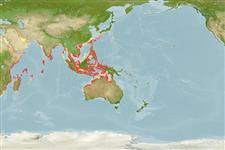Environment: milieu / climate zone / depth range / distribution range
Écologie
marin récifal; non migrateur; profondeur 1 - 30 m (Ref. 89707), usually 1 - 15 m (Ref. 90102). Tropical; 36°N - 34°S, 30°E - 143°E (Ref. 5222)
Indo-West Pacific: western India to Philippines, north to southern Japan (Honshu), south to northern Australia. 'Epinephelus formosus' from Madagascar (Ref. 6457), Réunion and Mauritius (Ref. 6458) are probably based on misidentifications of Cephalopholis polleni. Confused with Cephalopholis boenak.
Length at first maturity / Taille / Poids / Âge
Maturity: Lm 17.0 range ? - ? cm
Max length : 34.0 cm TL mâle / non sexé; (Ref. 4787)
Épines dorsales (Total): 9; Rayons mous dorsaux (Total): 15-17; Épines anales 3; Rayons mous anaux: 7 - 8. Characterized by: dark brown to yellowish brown color with narrow blue stripes; body with ctenoid scales, including abdomen; greatest depth of body 2.5-2.9 in SL; rounded caudal fin; pelvic fins, 1.6-2.0 in head length (Ref. 90102): head length 2.4-2.6 in SL; preorbital depth 3.6-4.3% SL, more than half maxilla width; convex interorbital area; rounded preopercle, finely serrate, lower edge fleshy; smooth subopercle and interopercle; maxilla naked, reaching to or just past vertical at rear edge of eye (Ref. 089707).
Like C. boenak, it prefers shallow dead or silty reefs and this may account for the primarily continental distributions of these two species. Solitary (Ref 90102).
Life cycle and mating behavior
Maturité | Reproduction | Frai | Œufs | Fécondité | Larves
Heemstra, P.C. and J.E. Randall, 1993. FAO Species Catalogue. Vol. 16. Groupers of the world (family Serranidae, subfamily Epinephelinae). An annotated and illustrated catalogue of the grouper, rockcod, hind, coral grouper and lyretail species known to date. Rome: FAO. FAO Fish. Synop. 125(16):382 p. (Ref. 5222)
Statut dans la liste rouge de l'IUCN (Ref. 130435)
Warning: mysqli::__construct(): (08004/1040): Too many connections in /var/www/html/includes/func_getlabel.php on line 46
Can't connect to MySQL database (fbapp). Errorcode: Too many connections
